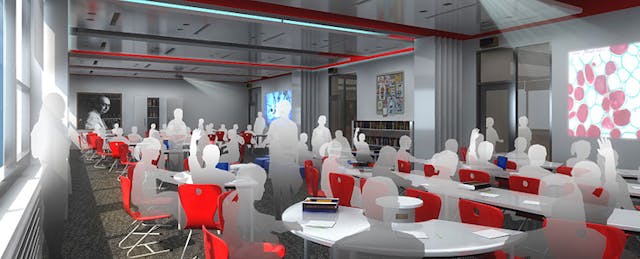Judy Beard, principal of Whittemore Park Middle School in Horry County SC, was so convinced that she had to implement “blended learning” to help her students achieve the common core that she started implementing blended learning before they had the funds to purchase the technology.
“It’s not about technology. It’s about instructional practice,” Ms. Beard told attendees at this year's iNACOL conference in a session entitled Panicked about the transition to Common Core? Learn how blended learning is helping some schools address the new rigors of common core.
“Start rotating the classroom” the award winning principal told the audience. She recounted how she split her class into three groups. At any one time, she could focus her attention on one third of the students while the other two thirds were kept engaged (one group was assigned to computers that she had moved from the computer lab, and the other group was assigned tasks that could be completed with pencil and paper). She said that when teachers saw how this practice allowed them to provide more differentiated instruction it was an easy transition to the technology; it simply made their practice even better. Gradually, through re-allocating Title I funds and leveraging E-rate, they have been moving towards 1:1 and strengthening the network. Ms. Beard insists the foundation was rotating the classroom.
Ms. Beard echoes a recurring theme at iNACOL this year: that schools must create the conditions to enable teachers to deliver more personalized, differentiated instruction to their students. And since US education funding is unlikely to increase anytime soon to allow substantial reductions in class size, schools MUST move towards a blended learning environment. But while there was consensus that technology was a valuable tool that can enhance instruction, no one prescribed any minimum or standard set of conditions that schools must provide to have a positive impact on student achievement.
iNACOL 2013 showcased several different blended learning models.
Rotational Labs
Students at 35 Highline Public Schools in Burien, Wash. rotate through computer labs as part of their daily schedule; students work individually at their own level and pace on adaptive software while the teacher circulates and provides help to individual students. Periodically, the teacher will gather several students together to address a learning difficulty they are all facing.
One-to-One Implementations
Similarly, teachers in several blended learning schools in the Oakland Unified School District in Calif. are able to provide face-to-face instruction to a small group of students in the center of the classroom while the majority of the students work independently on adaptive software loaded on to their Chromebooks. The software provides the teachers a continual stream of data pinpointing each student’s learning needs.
All Virtual
The Chicago Virtual Charter School which enrolls 680 students within Chicago Public Schools only requires 2 ¼ hours of “seat time” within the bricks and mortar school each week. Most of the time, teachers and students work and interact with each other remotely.
Steve Dackin, Superintendent of Reynoldsburg City Schools in Ohio gives his principals a lot of freedom to choose the model and the tools. “There is no one size fits all” says Dackin.
A study funded by the Bill and Melinda Gates Foundation has been tracking the financials of eight startup blended learning charter schools that received grants from the Foundation through its Next Generation Learning Challenge. As a condition of the grants, the schools are expected to reach breakeven solely with public funding in four years' time. The cohort comprises a diverse mix of blended learning models. Thus far, the study has found that per pupil spending on average was about the same as in traditional charter schools, but that the NextGen schools allocate their funds differently.
As you would expect, technology is earmarked for a larger slice of the budget than in traditional charter schools. However, when revenues fell short of projections in their first year, these schools delayed technology purchases and continued implementing their instructional plans, reflecting the general sentiment that technology is not the foundational driver of a blended learning program.
iNACOL speakers pointed out that more and more states are passing legislation allowing schools to innovate with blended and on-line learning. But attendees were also reminded that blended learning in the US is only three or four years old and is still in a state of flux. Rachel Klein at Highline Public Schools described her school's program as a “constant system of pilots.”
While there is a trend towards blended learning of some kind, the “degree of the blend” is a local decision, and must fit into the available funding. Some innovative educators who have recognized the need for blended learning are starting to transform their educational programs by re-allocating existing resources. Scott Milam of Afton Partners LLC, one of the collaborators in the financial study funded by the Gates Foundation, commented that these educators are making the “highest and best use of funding.”
And even when incremental funding is available, everyone agreed that purchasing devices and selecting software should not be the top priorities. Oakland Unified School District’s Tracey Logan recommended using the first influx of extra money to strengthen the network infrastructure and invest in people. Reynoldsburg’s Steve Dackin said districts have to “incentivize the behavior you want.”
Money is neither the prerequisite for starting a blended learning program nor the determinant of quality. As Center for Reinventing Public Education’s Bethany Gross pointed out “cost of blended is not the same as cost effectiveness of blended.” When starting out on the journey, noted Oakland's Logan, "less is more."


